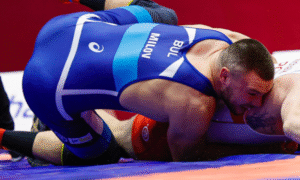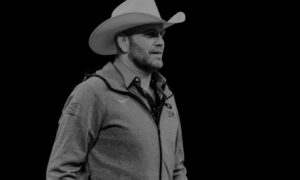This is the third in a four-part series of Greco-Roman wrestling positions and drills that was written, developed, and structured by 1995 World Champion, ’96 Olympic silver, ’94 World bronze, and ten-time US National titlist Dennis Hall.
Hall’s reputation as both a competitor and coach might lead those who encounter this material to surmise that the concepts illustrated therein are strictly for Greco-Roman. While it is true that all of the positions in this series are commonly practiced in the classical style, the skill-sets required to perform them are transferrable to the other disciplines, as well, most prominently scholastic and freestyle. To that point, Hall is currently the head coach of the University of Dubuque’s women’s program in addition to running the school’s regional training center (Dubuque RTC).
Part I of Wrestling’s Basic Truths outlined the fundamentals of “First Contact” (when wrestlers engage either in the beginning of a match or following a reset). The second part covered “Stance” and features explanations of drills along with graphic charts wrestlers and coaches can use during training.
DUBUQUE RTC ‘WRESTLING’S BASIC TRUTHS’
PART I — First Contact
PART II — Stance
PART III — Level Change
PART IV — Lifting

Part III: Level Change
A Level Change is a vertical movement at the hips. This is a critical point in executing any technique from your feet. A proper level change will result in the loading of your opponent, which in turn allows you to make actionable attempts to score.
CORRECT LEVEL CHANGE
1 — In order to perform a proper level change, you must be in the correct positional stance. Weight needs to be equally distributed throughout your feet and heavy into the mat (see Stance).
2– Your lead leg leverages the ground and loads your back foot. At this point, both feet should feel equal pressure throughout the foot. Notice when doing this that your hips slightly change elevation. The knee on your back leg will go slightly forward at this moment during execution. Now your hamstrings should be engaged, as well as your core.
3 — Next, drive your tailbone down by leveraging the mat. When the back of your knees reach a 90-degree angle, create a fish-hook motion with your hips by leveraging the mat with your back leg and drive slightly forward and up. Notice that you are back to your original stance.
LEVEL CHANGE DRILLS
1 — Get into the correct positional stance and place your hands on the wall to simulate your opponent’s shoulders. The distance from your armpit to elbow should be the same distance that your lead leg is away from the wall. Try having your arms bent at a 90 degree angle. This will prevent you from reaching and being out of center.
2 — Leverage the wall with your hands in an upward direction and leverage the mat with your feet. Both your feet and hands should have equal pressure being exerted. Notice that you are balanced and controlling your center of gravity. If you feel more pressure on the front of your foot it means that you are not engaging your hamstrings enough. Push your heels into the mat until your pressure evens out.
3 — Now perform a proper level change.

A correct positional stance has to be emphasized. As described under the first header, even weight distribution in both feet is critical. Your lead leg is responsible for leveraging the ground as your back foot is loaded. This is how you both maintain balance and set up to level change and attack. Your hip elevation will alter, and the knee on your back leg will ease forward upon executing this motion. Also important are the hamstrings. You should feel your hamstrings become activated along with your core. You then drive your tailbone down by leveraging the mat. Once the back of your knees hit a 90-degree angle, create that fish-hook motion with your hips by leveraging the mat with your back leg as you drive slightly forward and up. You should then notice that you are back in your original stance.
*NOTE: Notice your hands should come off the wall and go back to it after you finish the level change. We always want to maintain our stance. By maintaining your stance, it will help you to develop the habit of not reaching on an attack, be it a high-dive bodylock for Greco-Roman or a double/single-leg in one of the other styles.
LEVEL CHANGE DRILL TO AN ATTACK
This drill is designed to help you get to your attack in the correct positional stance and off-center your opponent if the shot isn’t available.
1 — Start in the correct positional stance. Correct positional stance is starting with your feet shoulder width apart. Take one step out to the side with each foot. This is an athletic stance. The dominant leg will step forward (right-handed wrestlers will lead with their right foot and left-handed wrestlers will lead with their left leg).
2 — Use your front leg and drive your foot into the mat and create backward pressure so that you have your weight loaded on your back foot.
3 — Pressure the mat with your back foot — and as your front foot touches the mat, leverage the mat hard with both feet. Make sure both feet are heavy into the mat with even pressure and change your elevation by lowering your tailbone so your knees are at a 90-degree angle. Now drive off of your back foot in a forward motion until you are back to your stance. Keep your feet heavy so that you stay low. Notice how you are in a lower balanced stance. If you are wrestling Greco-Roman and your opponent’s hips or lower torso are within reach — or if in folk or freestyle it is your opponent’s leg — you are now in a power position to finish. All of your leg muscles and core should be activated and firing.
BACKWARD LEVEL CHANGE
This drill is designed to help you stay in position when your opponent is pushing and trying to break your own position from your stance. Any time I feel forward pressure from an opponent, I use this technique. The backward level change, when performed correctly, causes your opponent to lean and become unstable due to losing their COG (center of gravity) and may lead to a scoring opportunity for you.
1 — Start by being a little higher in your stance. This will simulate upward and forward pressure from your opponent. Notice that you will have slightly more pressure on your back foot.
2 — Leverage the mat hard with your lead leg’s foot. This will help you stabilize your body so that you can transition to your back foot, which is carrying your COG.
3 — Take a step backwards with your back foot. The size of the step will be determined by the amount of pressure your opponent is exerting on you. Minimal pressure is the usual step size of 3-4 inches. High Pressure may be an 8-12 inch step backwards. If your opponent is pressuring hard with a lift at the same time causing you to be standing almost upright, a bigger step is necessary. Make sure when you step backward that you are leveraging the mat hard evenly with both feet.
4 — Drive your tailbone downward. Your back leg will be bent at a 90-degree angle. With downward pressure from both feet, drive your hips forward with a fish-hook motion. This may lead to a shot or, if an attempt is defended or unavailable, the regaining of your original stance.

PENETRATION STEP
A penetration step is an extremely important part of wrestling. Many see it a penetration step as the primary method to execute an attack or shot. When performed correctly, a penetration step often results in a takedown because you are in a strong and balanced position to finish. Points of leverage into the mat are obviously vital to understand and practice.
POINTS TO A CORRECT PENETRATION STEP
1 — Get into a correct positional staggered stance by starting with your feet shoulder width apart. Take one step out to the side with each foot. This is an athletic stance. The dominant leg will step forward (right-handed wrestlers will lead with their right foot and left-handed wrestlers will lead with left leg). This is a staggered stance. It is staggered because your feet are in a stride position.
2 — Next execute a forward level change. In order to do a proper level change, you need to be in the correct positional stance (observe the guidelines described under “Correct Level Change”).
3 — Drive your lead leg down into the mat with a good amount of pressure. The leverage of the downward pressure from the knee you are driving into the mat will and should have your body straight except for your trail leg. Notice that your core is engaged at this point. A failure to drive your knee into the mat hard enough will create a pike or bent position at your hips and cause you to lean and become unstable. Keep the toes of your lead leg curled and drive them into the mat, as well. Now you will have two stable points of contact into the mat to help resist the force your opponent may be applying at this time. Your back leg is also pressing into the mat with your toes, as well as creating more stability due to the pressure and activation of your muscles in that leg.
4 — Complete a 45-degree pivot on the knee that is down into the mat. As you pivot on that knee, lift your toes and complete the 45-degree pivot. Your toes will contact the mat again at the finish of the 45-degree pivot — and your toes on that leg will be curled and driving into the mat. As you pivot your back leg or drive leg, you will step forward within a ½ inch to one inch of your opponent’s foot. The location of your where your toes plant on the mat will be ½ the length of your opponent’s foot or in the middle of the outside your opponent’s foot. The majority of the weight on that foot will be on your big toe with the remaining toes being used for support. As your big toe pushes into the mat to create leverage, engage all muscles in your inner thigh to be used for an aggressive leverage. At the same time, drive that lower thigh just above the knee into your opponent’s leg just below their knee. This will impart a transfer in weight for your opponent to his outside foot. Your head is looking up and around your opponent’s back and tight to his body, all while applying constant pressure.
DO NOT LOSE CONTACT WITH YOUR OPPONENT
Throughout the entire action, your hands will be pulling the back of your opponents knees into your body (in folk or freestyle) or applying an inward and downward pressure with a pull motion. Your elbow should go down and closer to your side. Your right hand needs to be pulling towards you hard with constant pressure. This will cause your opponent’s knees to bend, thus assisting you with leverage. It is important that your shoulder on the knee that is down is driving into your opponents leg. Where your shoulder is on your opponent will depend on your opponent’s length.
Your shoulder should be in contact somewhere around the inner part of your opponent’s hip. While you are executing every technique above, (simultaneously) drive the toes of the foot deep and hard into the mat, and lift with all engaged muscles of your inner thigh. It is vital that your abs are completely engaged and locked. The knee that is down will lift and step at a 45-degree angle wide to the outside of your opponent’s foot. Be sure that your foot and step are at a 45-degree angle. If your foot isn’t at a 45-degree angle, it will lift cause your hips to lift and you will lose leverage.
You are driving your opponent over his outside leg, making it is critical that you keep pulling with constant pressure on your opponent’s outside leg. Do not expect your opponent to fall immediately. In order to use the leverage and make your opponent fall, you will need to complete 3-inch steps starting with the opposite foot and follow with the foot that was at a 45-degree angle until your opponent falls. When you step, it is likewise important that you stay heavy into the mat and engage not only your core, but all of the muscles in your body.

Listen to “5PM54: WCAP’s Ryan Epps and a Final X Greco-Roman Preview” on Spreaker.
SUBSCRIBE TO THE FIVE POINT MOVE PODCAST
iTunes | Stitcher | Spreaker | Google Play Music



















